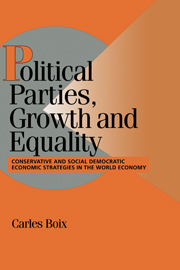 Political Parties, Growth and Equality
Political Parties, Growth and Equality Book contents
- Frontmatter
- Contents
- List of Tables and Figures
- Preface
- 1 Introduction
- 2 Political Parties and the Structural Conditions of the Economy
- 3 Supply-Side Economic Strategies from a Comparative Perspective (I): Public Investment and the Formation of Human Capital
- 4 Supply-Side Economic Strategies from a Comparative Perspective (II): The Public Business Sector and Tax Strategies
- 5 The Social Democratic Project: Macroeconomic Stability and State Intervention in Spain
- 6 The Political and Electoral Dimensions of the PSOE's Economic Strategy
- 7 Turning around the Postwar Consensus: Defining a Conservative Economic Framework in Britain
- 8 The Political and Electoral Dimensions of the Conservative Economic Strategy
- 9 Partisan Strategies and Electoral Coalitions
- 10 Conclusions
- Notes
- References
- Index
- More Titles in the Series
1 - Introduction
Published online by Cambridge University Press: 05 June 2012
- Frontmatter
- Contents
- List of Tables and Figures
- Preface
- 1 Introduction
- 2 Political Parties and the Structural Conditions of the Economy
- 3 Supply-Side Economic Strategies from a Comparative Perspective (I): Public Investment and the Formation of Human Capital
- 4 Supply-Side Economic Strategies from a Comparative Perspective (II): The Public Business Sector and Tax Strategies
- 5 The Social Democratic Project: Macroeconomic Stability and State Intervention in Spain
- 6 The Political and Electoral Dimensions of the PSOE's Economic Strategy
- 7 Turning around the Postwar Consensus: Defining a Conservative Economic Framework in Britain
- 8 The Political and Electoral Dimensions of the Conservative Economic Strategy
- 9 Partisan Strategies and Electoral Coalitions
- 10 Conclusions
- Notes
- References
- Index
- More Titles in the Series
Summary
In the last two decades, under the impact of increasing international integration and two oil shocks, the developed world has suffered broad structural changes in its economy. Since 1973, the average Organization for Economic Cooperation and Development (OECD) annual growth rate, which had fluctuated around 5 percent in the 1960s, has dropped to 2.6 percent. Such a sluggish economic performance has been accompanied by different – and to some extent opposite – phenomena in each advanced nation. In continental Europe, which has a relatively regulated labor market and extensive social policies, the private sector has created few jobs in the last twenty years and the unemployment rate has jumped from less than 3 percent before 1973 to over 10 percent in the mid-1990s. By contrast, in the United States and, to some extent, in the United Kingdom, which have substantially lower levels of labor and welfare protection, employment creation has soared. Yet, unfortunately, they have had to pay a high price for their economic dynamism: median wages have declined and the income distribution has widened – in fact reversing a secular trend that started at the end of World War II.
The economic changes of the last two decades have, in turn, stirred up public life and galvanized the political debate within industrial democracies, hastening the alternation in power of different parties and encouraging experimentation with opposing economic policies in many advanced countries.
- Type
- Chapter
- Information
- Political Parties, Growth and EqualityConservative and Social Democratic Economic Strategies in the World Economy, pp. 1 - 15Publisher: Cambridge University PressPrint publication year: 1998
